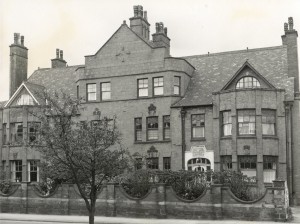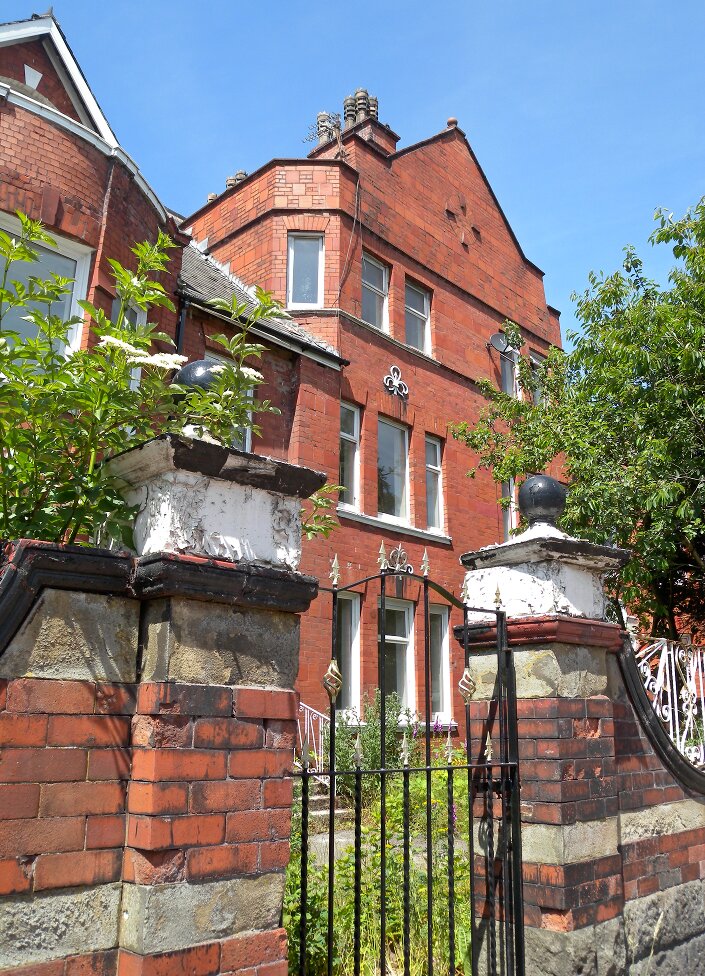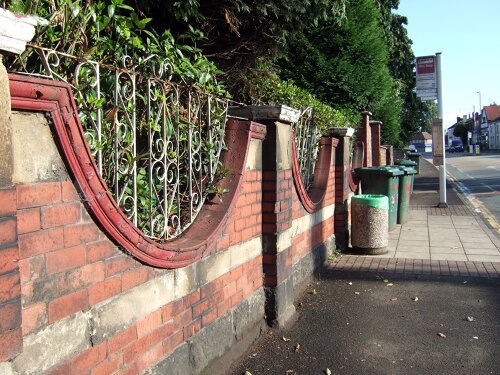Tonge Hall and Hopwood Hall have been added to the national Heritage at Risk Register, as well as Long Street Church. Click to read the MEN report
Three major buildings at risk for one medium sized town… it’s a bit much.
Tonge Hall and Hopwood Hall have been added to the national Heritage at Risk Register, as well as Long Street Church. Click to read the MEN report
Three major buildings at risk for one medium sized town… it’s a bit much.
Yesterday was one of those special days…. With just a few hours notice, BBC Radio and TV turned up to film the church and school. Why? Because English Heritage has just added the Long Street buildings to the national Heritage at Risk register, which is updated and published every year.
 First off, was BBC Radio Manchester and the Allan Beswick morning show – we were on towards the end and at 8.30am a presenter and radio technician came knocking at our door. Nick, David, Nick (from the Council) and Tim (from English Heritage) were there to welcome them and quickly show them around. Michelle, the presenter decided to have a live description from the Lecture Room looking into the garden and then a walk into the church via the vestry. We were all very nervous but they quickly put us at ease and it was a great experience being with such professional media people.
First off, was BBC Radio Manchester and the Allan Beswick morning show – we were on towards the end and at 8.30am a presenter and radio technician came knocking at our door. Nick, David, Nick (from the Council) and Tim (from English Heritage) were there to welcome them and quickly show them around. Michelle, the presenter decided to have a live description from the Lecture Room looking into the garden and then a walk into the church via the vestry. We were all very nervous but they quickly put us at ease and it was a great experience being with such professional media people.
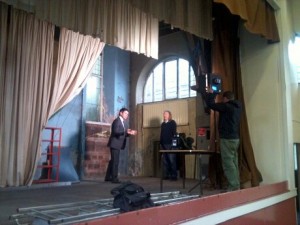 Having relaxed from our radio experience, TV came knocking at our door at 11am with Mark Edwardson, the NW Tonight presenter and cameraman. They wanted to do a slot for NW Today at lunchtime and a longer slot for the early evening NW Tonight. Again, we all gave them a tour round and they quickly got up to speed. They chose the corner of the School Hall stage for the shorter NW Today shoot as there is a good bit a grot there! As this was not live, they did three takes and then disapeared to edit and upload the film, while we had a sandwich or two.
Having relaxed from our radio experience, TV came knocking at our door at 11am with Mark Edwardson, the NW Tonight presenter and cameraman. They wanted to do a slot for NW Today at lunchtime and a longer slot for the early evening NW Tonight. Again, we all gave them a tour round and they quickly got up to speed. They chose the corner of the School Hall stage for the shorter NW Today shoot as there is a good bit a grot there! As this was not live, they did three takes and then disapeared to edit and upload the film, while we had a sandwich or two.
By now, Mair from English Heritage had replaced Tim and it was decided that three of us would be interviewed for the NW Tonight shoot. However, when setting up on the Hall balcony, Mark, the cameraman, got a large carbon fibre spinter in his finger from his tripod. This requires hospital A&E treatment so he had to go off imediately leaving Mark the presenter having to do the whole thing on his own, with a small backup camera he had in his car.
We now experienced BBC professionalism at its best as Mark Edwardson worked out a new 1 minute 45 second shoot in his head and then set-to using his little camera and a tripod. All the professional tricks came out – off-camera interviewing of Mair and Nick, Mark speaking to the camera on the tripod (he did six takes of the introduction in front of the crumbling wall of the stage), distant shots in the garden of David and Nick and a walk past with David, all blended together with stills of the building and its materials. It was a tour de force of improvisation.
It runs from October to January next year.
Great news for Middleton’s heritage – the Government and English Heritage have listed the Independent Labour Party Club on Milton Street as Grade II. This followed the submission of a scheme to convert it into flats. The listing specifically protects the inside as well as the outside of the building as being of special historic and architectural interest.
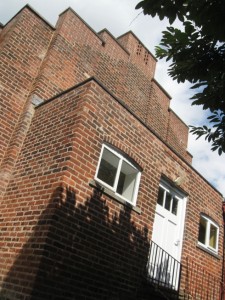 We are grateful to English Heritage for assessing the building in such a short time and to Nick Baker for such great photos..
We are grateful to English Heritage for assessing the building in such a short time and to Nick Baker for such great photos..
Another building of Midddleton’s Golden Cluster receives official recognition. We look forward to sensitive proposals to secure its future for the long term.
Here are the English Heritage listing documents, hot off the press…
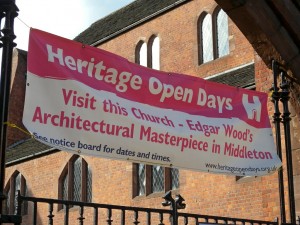 Golden Cluster Month has had another successful year with hundreds of people enjoying four heritage buildings open to the public and various events laid on.
Golden Cluster Month has had another successful year with hundreds of people enjoying four heritage buildings open to the public and various events laid on.
Things were brought to a close by Middleton Heritage Film Group’s ‘Enlightenment Middleton’ film, directed by Anthony Dolan. Over 80 people came to the premiere. This is a great documentary which brings to life Enlightenment heroes, Ashton Lever, George Cayley and Sam Bamford and Middleton’s unique Palladian house, Alkrington Hall. The film will shortly be uploaded to YouTube… we’ll let you know when it does.
Many thanks to all who made September ‘golden’ for Middleton’s heritage!
A new social enterprise may be formed to help save Edgar Wood’s Arts & Crafts Church at Long Street.
Christine Grime, Lee Wolf, Nick Baker and David Morris, two Middletonians and two ‘Wood-ies’ from further afield, have temporarily called it Arts & Crafts Awakening while they consult local people and visitors on the best way forward.
For years many have been almost ‘asleep’ to how special Edgar Wood’s buildings make Middleton. Arts & Crafts Awakening refers to Middletonians now ‘waking up’ to their wonderful Arts & Crafts heritage, not least to secure the future of Long Street Methodist Church and School, the finest in England.
What does the future hold for this Arts & Craft Church? If you have more time, let us know what you think by completing this short survey .
Middleton Heritage Film Group have worked all year on their fourth film about Middleton’s impressive heritage. Don’t miss the premiere coming up next Tuesday! Admission is free, thanks to money from the Heritage Lottery funded Edgar Wood and Middleton Heritage Initiative.
Enlightenment Middleton covers the area’s history of the 1700s and early 1800s. You will be surprised about the Middleton people of that time and what they achieved, a few of them gaining national and international fame for their outstanding lives.

Middleton’s Milton Street Family Centre was closed and sold a few years ago but not before it was lovingly restored by Middleton Township and Rochdale Council’s building repairs team.
New owners want to convert it into ten flats, something which would destroy the interior spaces, replace the lovely windows and install rooflights into the prominent Westmorland slate roof facing the road. The planning application is being considered by Rochdale Council planners and public comments can be seen and made here (the plans can be viewed also). Rochdale Council Conservation section comments have yet to be posted online.
The family centre was for a long time a nursery and before that it was Middleton’s Independent Labour Party Club House and HQ, built in 1912. Furthermore, it was designed by Edgar Wood in a very early Art Deco style. It is completely unique in England and an important monument to the growth of the Labour Movement in Middleton and Manchester. Here is an expert report on the building carried out by the Middleton Edgar Wood project Independent Labour Party Clubhouse, Middleton HBR aug 2014
We all want to see this fantastic monument in the conservation area reused but the current proposals need modifying to prevent irreversible harm to part of Middleton’s unique Golden Cluster of heritage buildings.
This was a day trip organised by the Friends of The Edgar Wood Centre in Middleton to see some Arts & Crafts highlights. We all met at the Arts and Crafts Church and boarded a coach bound for the mecca for northern Arts & Crafts… The lake District.
 Our first stop was at Staveley Parish Church to view the magnificent East window designed and built by William Morris and Edward Burne-Jones (the photo is just one small pane).
Our first stop was at Staveley Parish Church to view the magnificent East window designed and built by William Morris and Edward Burne-Jones (the photo is just one small pane).
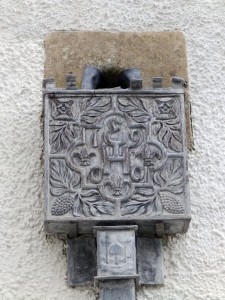
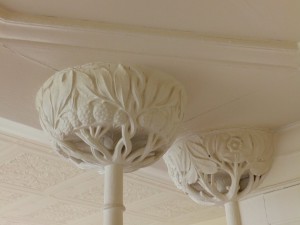
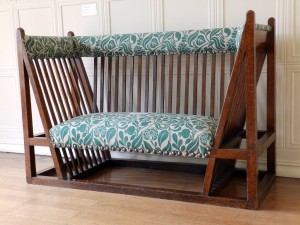 We then travelled to the highlight of our trip, Blackwell, Windermere built between 1898 and 1900, a masterpiece designed by Mackay Hugh Baillie Scott. With a rather chequered history it has somehow managed to retain many of its original features and is considered to be the best example of its type open to the public.
We then travelled to the highlight of our trip, Blackwell, Windermere built between 1898 and 1900, a masterpiece designed by Mackay Hugh Baillie Scott. With a rather chequered history it has somehow managed to retain many of its original features and is considered to be the best example of its type open to the public.
After a brief introduction from a local guide we enjoyed a light lunch before wandering at will to admire the very fine craftsmanship not only of the building but also the contents. Built as a holiday home for Sir Edward Holt, a brewing magnate it has magnificent views over the lake.
Our next stop was at Broad Leys now the headquarters of the Windermere Motor Boat Racing Club but designed by Charles FA Voysey as a large house, again in the Arts & Crafts style.
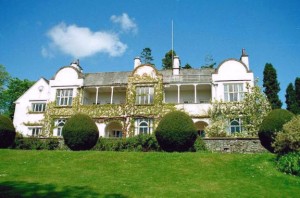 Finally we enjoyed a walk round the gardens and refreshments at Brockhall Visitor Centre (below) although none of us ventured onto the aerial walkways and runway. Comments like ‘It’s too busy’, ‘I’m not prepared to queue’, ‘We haven’t got time’ were uttered at regular intervals!
Finally we enjoyed a walk round the gardens and refreshments at Brockhall Visitor Centre (below) although none of us ventured onto the aerial walkways and runway. Comments like ‘It’s too busy’, ‘I’m not prepared to queue’, ‘We haven’t got time’ were uttered at regular intervals!
Our thanks to Christine and Geoff for their hard work in organising such an excellent day.
Long Street looks lovely in spring with the Jubilee Library cherry blossom out and the trees coming into leaf. This panorama shows how Middleton’s Jubilee Library was designed to respect the timber-framed Old Boar’s Head. The library is an early and unusual Arts & Crafts design and there is only one other listed Arts & Crafts library in England of such an early date.
The official architect was Laurence Booth of Bury who won the competition for designing the library. However, he built nothing like it before or afterwards. Instead, the building is in Edgar Wood’s early Arts & Crafts style (he was aged 29 in 1889).
Edgar Wood’s father and his main client (Schwabe) were the two principal funders of the library and many of the other large funders were also Edgar Wood clients. We think that Laurence Booth was a front to hide Edgar’s involvement as he could not have fairly competed and it would have have been controversial for him to do so. There are many clues in the surviving records that this was the case and that Edgar Wood was indeed the true designer.
In this way, Edgar Wood appears to have designed the town’s first public library creating a state of the art design some ten years before Arts & Crafts architecture began to take off. Consequently, the Library is now firmly on the Edgar Wood heritage trail!
Edgar Wood’s avant garde buildings were very contentious locally and he had to take a very low profile in the design of publicly funded buildings. Similar methods were used to hide his involvement in the design of Long Street Methodist, the Arts & Crafts Church, when he was only revealed as architect at the last minute in December 1898 after all the decisions had been made. Likewise, he was hidden from view in the restoration of the Parish Church and, as one of the leading town planners of England, we also think he was the hidden designer of Alkrington Garden Village. The official designer, Thomas Adams, would have known Edgar as they were both involved in Letchworth Garden City, Hertfordshire.
The Library is full of Arts & Crafts features, like the traditional pegged oak construction used for the timber work (which Mr. Booth complained about!). The reinforced concrete construction of the first floor is another Arts & Crafts experimental feature. Blending traditional handicrafts with modern methods like reinforced concrete were very much Edgar Wood’s approach. Later on, he became famous for his flat concrete roofs and for pioneering modern design.
CLICK HERE to enlarge the photo.
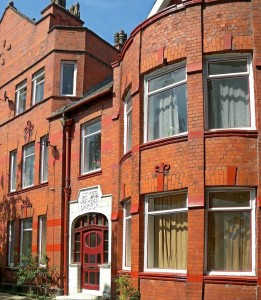 In the early days of Arts & Crafts architecture, pioneers like Edgar Wood experimented with a variety of materials and forms, trying to find a new way in design. The semi-detached pair of houses on Rochdale Road, Middleton, Briarhill & Hillcrest, is one of these and represents an art nouveau ‘town’ approach to design in contrast to the vernacular revival ‘country’ approach of Redcroft & Fencegate next door.
In the early days of Arts & Crafts architecture, pioneers like Edgar Wood experimented with a variety of materials and forms, trying to find a new way in design. The semi-detached pair of houses on Rochdale Road, Middleton, Briarhill & Hillcrest, is one of these and represents an art nouveau ‘town’ approach to design in contrast to the vernacular revival ‘country’ approach of Redcroft & Fencegate next door.
Their appearance could not have been more different, with bright red Ruabon bricks, tall angular symmetry and pioneering Art Nouveau forms. This striking and original building, now considerably at risk in 2016, is one of the world’s first art nouveau buildings and takes no prisoners in its powerful expression. It was so advanced in its day that the design was published across Britain, Europe and USA and it set the trend for other ‘all red’ buildings.
Some people struggle to like it, though others adore its bold and uncompromising impact.The use of identically coloured red brick and terracotta was approved of by William Morris, where the smoky atmosphere required such materials. However, when it came to the roof, Edgar Wood did something no other architect had thought of, he mix five different types of slate from around the country, to create a mottled impressionistic surface – an idea transferred from the realm of painting to building.
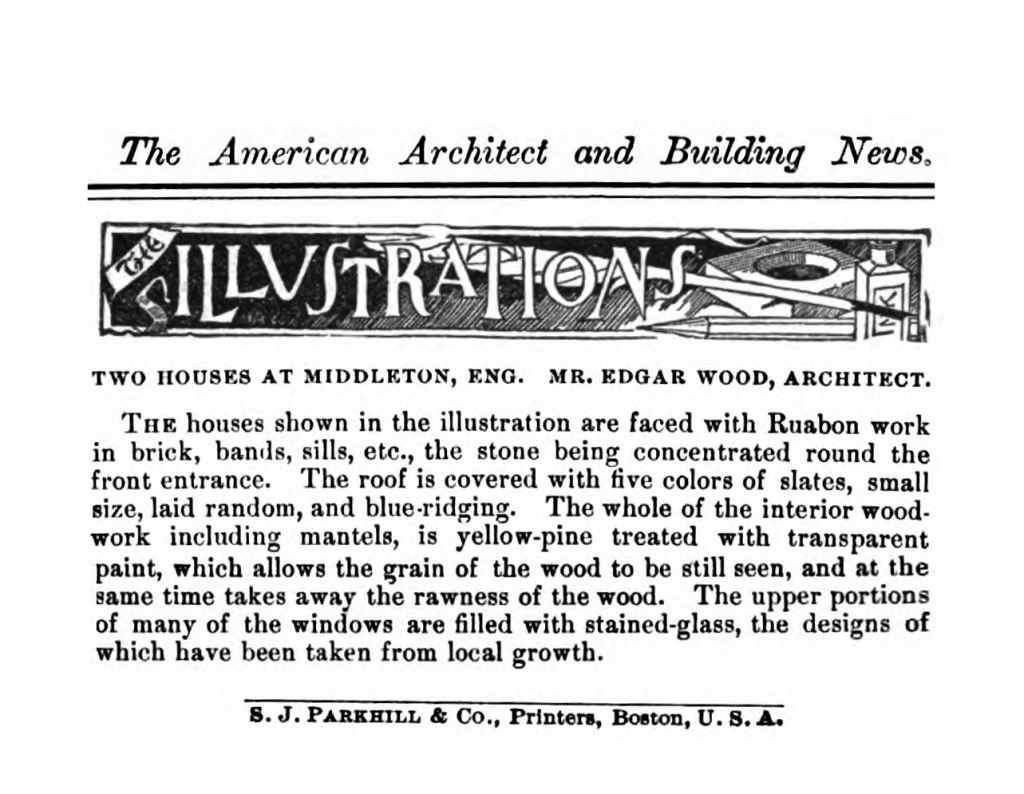 The building was illustrated in the USA publication, American Architect and Building News a year later. This magazine was published in Boston and would have been admired by the early Arts and Crafts designers of the eastern States.
The building was illustrated in the USA publication, American Architect and Building News a year later. This magazine was published in Boston and would have been admired by the early Arts and Crafts designers of the eastern States.
